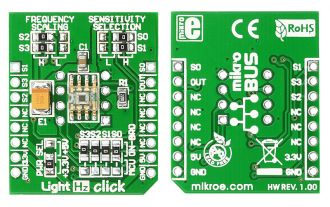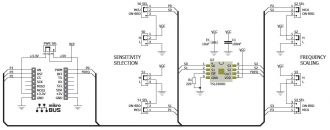
We strongly encourage users to use Package manager for sharing their code on Libstock website, because it boosts your efficiency and leaves the end user with no room for error. [more info]

Rating:
Author: MIKROE
Last Updated: 2016-02-18
Package Version: 1.0.0.0
Example: 1.0.0.0
Category: Optical
Downloaded: 6261 times
Followed by: 2 users
License: MIT license
This project demonstrates working with TSL230RD.
Pulses from TSL230BR are counted using RB0/INT interrupt on rising edge on pin RB0 of PIC18F45K22 MCU. Timer1 generates interrupt after 1/4 second for calculating frequency.
Do you want to subscribe in order to receive notifications regarding "LightHz click - Example" changes.
Do you want to unsubscribe in order to stop receiving notifications regarding "LightHz click - Example" changes.
Do you want to report abuse regarding "LightHz click - Example".

Front and back view of LightHz click board designed in mikroBUS form factor. mikroBUS is specially designed pinout standard with SPI, I2C, Analog, UART, Interrupt, PWM, Reset and Power supply pins.
View full imageTSL230BR is a programmable light-to-frequency converter. The output can be either a pulse train or a square wave (50% duty cycle) with frequency directly proportional to light intensity. Device sensitivity and frequency scaling can be selected using available SMD jumpers.
Examples are written for:
- EasyPIC v7 - PIC18F45K22
- EasyPIC PRO v7 - PIC18F87K22
- EasyMx PRO v7 for Stellaris(R) - LM3S9B95, LM4F232H5QD
- EasyMX PRO v7 for ST - STM32F107VC
- EasyPIC v7 for dsPIC30 - dsPIC30F4013
- EasyAVR v7 - ATmega32

Board is set to use 3.3V power supply by default. Solder PWR SEL SMD jumper to 5V position if used with 5V systems.
View full image